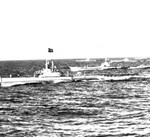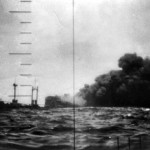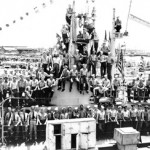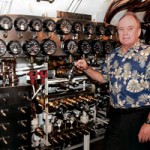The ‘Pearl Harbor Avenger’ Turns 70
The submarine christened exactly one year after the attack on Pearl Harbor served heroically in WWII, and today proudly carries on a mission of education and remembrance
She may be past her prime, but the old gal has never looked so good. Even after a long career in Hollywood and hosting some 1,000 visitors a day, the USS Bowfin has never shined so brightly. Her long life is testament to the hundreds of caregivers who have turned the once moth-balled submarine into a floating museum and memorial for all those who served in the Silent Service, whether in peace or during times of war.
This was an important caveat to taking ownership from the Navy, which required the Bowfin to be maintained in a manner befitting a U.S. Navy vessel and heritage of the submarine service.
“The Bowfin has been here since 1981, and we’ve taken what was essentially a dump from the Navy and turned it into this beautiful park, and we’re getting ready to welcome our 7-millionth paid visitor.” says Gerald Hofwolt, executive director of the USS Bowfin Submarine Museum and Park and a former submarine commander.
“That’s really a success story when you consider how the economy has gone up and down. We have created this facility through the work of a lot of different people with a lot of different visions.”
After the attack on Pearl Harbor, the U.S. submarine service was called on to take the fight to imperial Japan while the rest of the Pacific fleet recovered from the nearly disastrous blow. Within days of the attack, U.S. submarines were steaming toward Japan in the hunt for targets that would not only hamper Japan’s war effort but strike a decisive blow to its national economy. They accomplished both with astounding efficiency and bravery.
It wasn’t an easy mission. Torpedoes at the time were woefully inefficient – they either ran too deep to be effective or simply failed to detonate. Of the 21 boats (the Navy’s term for submarines) that were stationed at Pearl Harbor, only 11 were considered fit for combat duty. Yet the crews went charging out against a dangerous enemy on missions that would take the lives of one of every four submariners.
Though comprising just 2 percent of the Navy’s inventory, submarines accounted for 30 percent of all Japanese ships sunk during the war, including eight aircraft carriers, one battleship and 11 cruisers, and more than 60 percent of the Japanese merchant fleet. The Bowfin was one of those heroic platforms.
Launched exactly one year after the attack on Pearl Harbor and nicknamed the “Pearl Harbor Avenger,” the Bowfin sank 16 enemy vessels. So impressive were the accomplishments of the 220 men who manned the ship during its nine war patrols, the ship was immortalized in the 1957 movie, Hellcats of the Navy, which was loosely based on the exploits of the Bowfin and the eight-sub “Wolf Pack” it was a part of that wreaked havoc on Japanese shipping.
That’s the story the museum tells, and it’s not an easy one to put together. None of the 52 submarines lost in World War II have been recovered, nor do we know where they came to rest. It’s the same with most of the 3,600 submariners who are entombed in the vessels. It’s because of these reasons that Bowfin is so important.
“We tell the Navy’s stories, we tell the Navy history, we really define for the public the cost of freedom, and that’s the mission we serve,” says Hofwolt. “It’s to bring to the public the high cost of defending freedom in the far reaches of the world where there are bad people. It doesn’t matter if it’s history or now, we still tell the component cost being paid for by the young faces on our walls. You can take pictures of submariners, servicemen, soldiers, Marines, their faces would fit right in with the faces on our walls. The 19-, 20-, 22-year-olds are the ones who are on those squads, in those ships and in those planes.”
This year marks Bowfin’s 70th anniversary, and the museum is using the occasion to reintroduce itself to the public by offering half-price admission to adults and free admission to kids under 12. There is a photography contest for high school students. And its 7 millionth visitor, who should cross the bow this week, will receive a long weekend for four on Maui, airfare, hotel, rental and even some spending money. Also, until Dec. 8, visitors to the park can meet Bowfin veteran Dr. Robert Beynon, who was aboard during its final two tours of duty during WWII and who will autograph his book, Pearl Harbor Avenger. For more information on the photo contest and all anniversary events, go to the website, bowfin.org.
If you haven’t been to Bowfin or any of the other attractions at Pearl Harbor in a number of years, you’ll be surprised by the changes. Gone are the long lines, lack of accommodations and fences segmenting the area. The area now resembles an open park with plenty cool places to rest, things to eat, spectacular views of Pearl Harbor, museums, gift shops and the Waterfront Memorial, which is a quiet spot for reflecting on the history of the area and on those who made the ultimate sacrifice. Access has never been easier. Entrance to the park is from a single location and tickets for any of the attractions, whether the Arizona Memorial, Bowfin, USS Missouri or Pacific Aviation Museum can be purchased from a single area.
“The four of us, with the National Parks Service, have really created a consortium,” says Hofwolt. “We meet weekly to discuss issues. This year we created a site called recreation.gov where you can now, for the first time, can get tickets to the Arizona Memorial for a specific time and date. What we are doing at this weekly meeting is to look at how we can outreach to the public to make the public’s tour more enjoyable, more meaningful and more educational.”
Visitors can also choose from all-day passes, which allows them to visit each of the attractions, or tickets to individual sites.
Just as the mission of the museum is to celebrate the past, Hofwolt says it is critical to plan for the future. One way is to further improve the visitor experience at the museum. Already, customers get free audio tours of the submarine, but plans are being made to increase the museum space to tell the story of the submarine service beyond WWII and into the Cold War. In addition to its education mission is a scholarship program for Hawaii-based submariners and their families.
“My predecessor, Capt. Harvey Gregg, had started a scholarship program in 1985 that began giving scholarships to the children of submariners. There is also a continuation program that provides scholarships to the wives and active duty submariners. We were taking money from our operations account and with the help of the board of directors we’ve created an endowment that has grown to $600,000.”
With such efforts in place, Bowfin’s next 70 years may be as important as its first 70.
- Former submarine skipper Gerald Hofwolt now helms the USS Bowfin Submarine Museum and Park at Pearl Harbor. Rachel Breit photo
- The Bowfin was part of the vaunted ‘Wolf Pack’ that helped turn the tide in the Pacific. Photos courtesy USS Bowfin
- A periscope shot shows damage the Bowfin did to Japanese ships
- The Bowfin crew on July 4, 1945. Photo courtesy USS Bowfin Submarine Museum
- Gerald Hofwolt in the control room of the Bowfin. Rachel Breit photo








